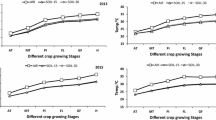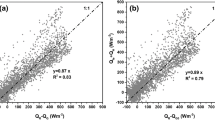Abstract
A field experiment was conducted at Indian Council of Agricultural Research-National Rice Research Institute, Cuttack, Odisha, India in the dry seasons of 2015 and 2016 to assess the water vapor flux (FH2O) and its relationship with other climatic variables. The FH2O and climatic variables were measured by an eddy covariance system and a micrometeorological observatory. Daily mean FH2O during the dry seasons of 2015 and 2016 were 0.009–0.092 g m−2 s−1 and 0.014–0.101 g m−2 s−1, respectively. Seasonal average FH2O was 14.6% higher in 2016 than that in 2015. Diurnal variation for FH2O showed a bell-shaped curve with its peak at 13:30–14:00 Indian Standard Time (IST) in both the years. Carbon dioxide flux was found higher with rise in FH2O. This relationship was stronger at higher vapor pressure deficit (VPD) (20 ≤ VPD ≤ 40 and VPD > 40 hPa). The FH2O showed significant positive correlation with latent heat flux, net radiation flux, photosynthatically active radiation, air, water and soil temperatures, shortwave down and upwell radiations, maximum and minimum temperatures, evaporation, and relative humidity in both the years. Principal component analysis showed that FH2O was very close to latent heat flux in both the years (Pearson correlation coefficient close to 1). The two-dimensional observation map of the principal component F1 and F2 showed the observations taken during the vegetative stage and panicle initiation stage, and flowering stage and maturity stage were closer to each other. It can be concluded that the most important climatic variables controlling the FH2O were latent heat of vaporization, net radiation, air temperature, soil temperatures, and water temperature.




Similar content being viewed by others
References
Alberto, M. C., Wassmann, R., Hirano, T., Miyata, A., Kumar, A., Padre, A., & Amante, M. (2009). CO2/heat fluxes in rice fields: comparative assessment of flooded and non-flooded fields in the Philippines. Agricultural and Forest Meteorology, 149(10), 1737–1750.
Anonymous (2018) https://www.statista.com/statistics/271969/world-rice-acreage-since-2008/ visited on 6th July 2018.
Attarod, P., Komori, D., Hayashi, K., Aoki, M., Ishida, T., Fukumura, K., Boonyawat, S., Polsan, P., Tongdeenok, P., Somboon, P., & Punkngum, S. (2005). Comparison of the evapotranspirations among a paddy field, cassava plantation and teak plantation in Thailand. Journal of Agricultural Meteorology, 60(5), 789–792.
Aubinet, M., Grelle, A., Ibrom, A., Rannik, Ü., Moncrieff, J., Foken, T., Kowalski, A. S., Martin, P. H., Berbigier, P., Bernhofer, C., Clement, R., Elbers, J., Granier, A., Grünwald, T., Morgenstern, K., Pilegaard, K., Rebmann, C., Snijders, W., Valentini, R., & Vesala, T. (2000). Estimates of the annual net carbon and water exchange of forests: the EUROFLUX methodology. Advances in Ecological Research, 30, 113–175.
Bouman, B. A., Peng, S., Castaneda, A. R., & Visperas, R. M. (2005). Yield and water use of irrigated tropical aerobic rice systems. Agricultural Water Management., 74(2), 87–105.
Burba, G. (2013). Eddy covariance method. Lincoln: Li-COR Biogeosciences.
Chatterjee, D., Tripathi, R., Chatterjee, S., Debnath, M., Shahid, M., Bhattacharyya, P., Swain, C. K., Tripathy, R., Bhattacharya, B. K., & Nayak, A. K. (2019). Characterization of land surface energy fluxes in a tropical lowland rice paddy. Theoretical and Applied Climatology, 136(1-2), 157–168. https://doi.org/10.1007/s00704-018-2472-y.
Du, Q., Xing, G., Jiao, X., Song, X., & Li, J. (2018). Stomatal responses to long-term high vapor pressure deficits mediated most limitation of photosynthesis in tomatoes. Acta physiologiae plantarum, 40(8), 149. https://doi.org/10.1007/s11738-018-2723-7.
Edburg, S. L., Stock, D., Lamb, B. K., & Patton, E. G. (2012). The effect of the vertical source distribution on scalar statistics within and above a forest canopy. Boundary-Layer Meteorology, 142(3), 365–382. https://doi.org/10.1007/s10546-011-9686-1.
Falge, E., Baldocchi, D., Olson, R., Anthoni, P., Aubinet, M., Bernhofer, C., Burba, G., Ceulemans, R., Clement, R., Dolman, H., & Granier, A. (2001). Gap filling strategies for long term energy flux data sets. Agricultural and Forest Meteorology, 107(1), 71–77.
Goulden, M. L., Munger, J. W., Fan, S. M., Daube, B. C., & Wofsy, S. C. (1996). Measurements of carbon sequestration by long-term eddy covariance: methods and a critical evaluation of accuracy. Global Change Biology, 2(3), 169–182.
Hatala, J. A., Detto, M., Sonnentag, O., Deverel, S. J., Verfaillie, J., & Baldocchi, D. D. (2012). Greenhouse gas (CO2, CH4, H2O) fluxes from drained and flooded agricultural peatlands in the Sacramento-San Joaquin Delta. Agriculture, Ecosystems & Environment., 150, 1–8.
Huang, Z., Dong, X., Jiang, G., & Yuan, W. (2002). Primary studies on the daily dynamic changes of photosynthesis and transpiration of Salix psammophila. Acta Botanica Boreali-Occidentalia Sinica, 22(4), 817–823.
Huang, J., Katul, G., & Albertson, J. (2013). The role of coherent turbulent structures in explaining scalar dissimilarity within the canopy sublayer. Environmental Fluid Mechanics, 13(6), 571–599. https://doi.org/10.1007/s10652-013-9280-9.
Ju W, Chen JM, Black TA, Barr AG, Liu J, Chen B. (2006). Modelling multi-year coupled carbon and water fluxes in a boreal aspen forest. Agricultural and Forest Meteorology, 140, 136–151. https://doi.org/10.1016/j.agrformet.2006.08.008.
Kaimal, J. C., Finnigan, J. J. (1994). Atmospheric boundary layer flows. Oxford University Press. https://doi.org/10.1016/0012-8252(94)90026-4.
Klosterhalfen, A., Graf, A., Brüggemann, N., Drüe, C., Esser, O., González-Dugo, M. P., Heinemann, G., Jacobs, C. M., Mauder, M., Moene, A. F., & Ney, P. (2019). Source partitioning of H2O and CO2 fluxes based on high-frequency eddy covariance data: a comparison between study sites. Biogeosciences, 16(6), 1111–1132.
Kumagai, T. O., Saitoh, T. M., Sato, Y., Takahashi, H., Manfroi, O. J., Morooka, T., Kuraji, K., Suzuki, M., Yasunari, T., & Komatsu, H. (2005). Annual water balance and seasonality of evapotranspiration in a Bornean tropical rainforest. Agricultural and Forest Meteorology, 128(1-2), 81–92.
Law, B. E., Falge, E., Gu, L. V., Baldocchi, D. D., Bakwin, P., Berbigier, P., Davis, K., Dolman, A. J., Falk, M., Fuentes, J. D., & Goldstein, A. (2002). Environmental controls over carbon dioxide and water vapor exchange of terrestrial vegetation. Agricultural and Forest Meteorology, 113(1), 97–120.
Li, J., Liu, Y., Yang, X., & Li, J. (2006). Studies on water-vapor flux characteristic and the relationship with environmental factors over a planted coniferous forest in Qianyanzhou Station. Acta Ecologica Sinica, 26(8), 2449–2456.
Mahrt, L., & Vickers, D. (2002). Relationship of area-averaged carbon dioxide and water vapour fluxes to atmospheric variables. Agricultural and Forest Meteorology, 112, 195–202. https://doi.org/10.1016/S0168-1923(02)00079-5.
Massmann, A., Gentine, P., Lin, C.. (2018). When does vapor pressure deficit drive or reduce evapotranspiration?. arXiv preprint arXiv:1805.05444.
Mauder, M., Foken, T. (2011). Documentation and instruction manual of the eddy covariance software package TK3, Work Report University of Bayreuth, Dept. of Micrometeorology, ISSN: 1614-8916, pp. 46, 58.
Mauder, M., Liebethal, C., Göckede, M., Leps, J. P., Beyrich, F., & Foken, T. (2006). Processing and quality control of flux data during LITFASS-2003. Boundary-Layer Meteorology, 121(1), 67–88.
Nay-Htoon, B., Xue, W., Lindner, S., Cuntz, M., Ko, J., Tenhunen, J., Werner, C., & Dubbert, M. (2018). Quantifying differences in water and carbon cycling between paddy and rainfed rice (Oryza sativa L.) by flux partitioning. Plos One, 13(4), e0195238. https://doi.org/10.1371/journal.pone.0195238.
Pakoktom, T., Aoki, M., Kasemsap, P., Boonyawat, S., & Attarod, P. (2009). CO2 and H2O fluxes ratio in paddy fields of Thailand and Japan. Hydrological Research Letters, 3, 10–13.
Pathak H, Nayak AK, Jena M, Singh ON, Samal P and Sharma SG (Eds.) (2018) Rice Research for Enhancing Productivity, Profitability and Climate Resilience, ICAR-National Rice Research Institute, Cuttack, Odisha, p 527.
Perez-Priego, O., Katul, G., Reichstein, M., El-Madany, T. S., Ahrens, B., Carrara, A., Scanlon, T. M., & Migliavacca, M. (2018). Partitioning eddy covariance water flux components using physiological and micrometeorological approaches. Journal of Geophysical Research: Biogeosciences, 123(10), 3353–3370.
Reichstein, M., Falge, E., Baldocchi, D., Papale, D., Aubinet, M., Berbigier, P., Bernhofer, C., Buchmann, N., Gilmanov, T., Granier, A., & Grünwald, T. (2005). On the separation of net ecosystem exchange into assimilation and ecosystem respiration: review and improved algorithm. Global Change Biology, 11(9), 1424–1439. https://doi.org/10.1111/j.1365-2486.2005.001002.x.
Runkle, B. R., Wille, C., Gažovič, M., & Kutzbach, L. (2012). Attenuation correction procedures for water vapour fluxes from closed-path eddy-covariance systems. Boundary-Layer Meteorology, 142(3), 401–423.
Saito, M., Miyata, A., Nagai, H., & Yamada, T. (2005). Seasonal variation of carbon dioxide exchange in rice paddy field in Japan. Agricultural and Forest Meteorology, 135(1-4), 93–109.
Schneider, T., O’Gorman, P. A., & Levine, X. J. (2010). Water vapor and the dynamics of climate changes. Reviews of Geophysics, 48(3), 1–22. https://doi.org/10.1029/2009RG000302.
Shekhar DC (2013) Greenhouse gas emissions CH4, CO2 and N2O from a newly flooded hydroelectric reservoir in subtropical South Asia: the case of Nam Theun 2 Reservoir, Lao PDR. Doctoral dissertation, Université Paul Sabatier-Toulouse III.
Swain CK, Bhattacharyya P, Singh NR, Neogi S, Sahoo RK, Nayak AK, Zhang G, Leclerc MY (2016). Net ecosystem methane and carbon dioxide exchange in relation to heat and carbon balance in lowland tropical rice. Ecological Engineering, 95, 364–374. https://doi.org/10.1016/j.ecoleng.2016.06.053.
Swain, C. K., Bhattacharyya, P., Nayak, A. K., Singh, N. R., Chatterjee, D., Dash, P. K., Neogi, S., & Pathak, H. (2018a). Temporal variation of energy fluxes during dry season in tropical lowland rice. MAPAN-Journal of Metrology society of India, 33, 241–251. https://doi.org/10.1007/s12647-018-0260-x.
Swain, C. K., Nayak, A. K., Bhattacharyya, P., Chatterjee, D., Chatterjee, S., Tripathi, R., Singh, N. R., & Dhal, B. (2018b). Greenhouse gas emissions and energy exchange in wet and dry season rice: eddy covariance-based approach. Environmental Monitoring Assessment, 190, 423. https://doi.org/10.1007/s10661-018-6805-1.
Swain CK, Bhattacharyya P, Nayak AK, Singh NR, Neogi S, Chatterjee D, Pathak H. (2018c). Dynamics of net ecosystem methane exchanges on temporal scale in tropical lowland rice. Atmospheric environment, 191, 291–301. https://doi.org/10.1016/j.atmosenv.2018.08.011.
Thanawong, K., Perret, S. R., & Basset-Mens, C. (2014). Eco-efficiency of paddy rice production in Northeastern Thailand: a comparison of rain-fed and irrigated cropping systems. Journal of Cleaner Production, 73, 204–217.
Tseng, K. H., Tsai, J. L., Alagesan, A., Tsuang, B. J., Yao, M. H., & Kuo, P. H. (2010). Determination of methane and carbon dioxide fluxes during the rice maturity period in Taiwan by combining profile and eddy covariance measurements. Agricultural and Forest Meteorology, 150(6), 852–859.
Vickers, D., & Mahrt, L. (1997). Quality control and flux sampling problems for tower and aircraft data. J. Atmos. Oceanic Technology, 14, 512–526.
Wang, C., Lai, D. Y., Sardans, J., Wang, W., Zeng, C., & Peñuelas, J. (2017). Factors related with CH4 and N2O emissions from a paddy field: clues for management implications. PloS one, 12(1), e0169254. https://doi.org/10.1371/journal.pone.0169254.
Webb, E. K., Pearman, G. I., & Leunin, R. (1980). Correction of flux measurements for density effects due to heat and water vapour transfer. Quarterly Journal of the Royal Meteorological Society, 106, 85–100.
Wei, Z., Yoshimura, K., Okazaki, A., Kim, W., Liu, Z., & Yokoi, M. (2015). Partitioning of evapotranspiration using high-frequency water vapor isotopic measurement over a rice paddy field. Water Resources Research, 51(5), 3716–3729.
Yang, S., Xu, J., Liu, X., Zhang, J., & Wang, Y. (2016). Variations of carbon dioxide exchange in paddy field ecosystem under water-saving irrigation in Southeast China. Agricultural Water Management, 166, 42–52.
Acknowledgments
The authors sincerely acknowledge the scientists, students, and technical staffs who have maintained the eddy covariance site since its establishment.
Funding
The work has been supported by the grant of National Innovations on Climate Resilient Agriculture (NICRA), Indian Council of Agricultural Research, New Delhi.
Author information
Authors and Affiliations
Corresponding author
Ethics declarations
Conflict of interest
The authors declare that they have no conflict of interest.
Additional information
Publisher’s note
Springer Nature remains neutral with regard to jurisdictional claims in published maps and institutional affiliations.
Rights and permissions
About this article
Cite this article
Chatterjee, D., Nayak, A.K., Vijayakumar, S. et al. Water vapor flux in tropical lowland rice. Environ Monit Assess 191, 550 (2019). https://doi.org/10.1007/s10661-019-7709-4
Received:
Accepted:
Published:
DOI: https://doi.org/10.1007/s10661-019-7709-4




